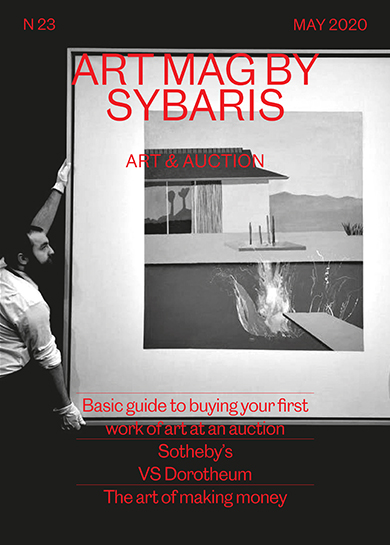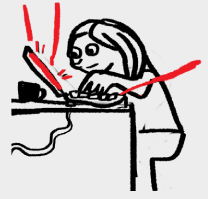Art & Auction

This issue of Art Mag addresses one of the most exciting topics for collectors: the power of auctions. Discover tips for buying at auctions. What are the most controversial auctions in recent years? Which auction houses are the most important today?
The Art Value Report analyzes the work of hyper realistic artist Carole Feuerman.
| BASIC GUIDE TO BUYING YOUR FIRST WORK OF ART AT AN AUCTION | 18 |
| DOROTHEUMVSSOTHEBY ‘S | 24 |
| THE ART OF MAKING MONEY: THE 5 MOST CONTROVERSIAL ART AUCTIONS OF RECENT TIMES | 30 |
| IS THE ART MARKET NECESSARY FOR ART TO EXIST? | 36 |
| 10 PIECES TO MEET MEL BOCHNER | 40 |
| ART VALUE REPORT CAROLE FEUERMAN | 53 |
BASIC GUIDE TO BUYING
YOUR FIRST WORK OF ART
AT AN AUCTION
By Lucía Peñalosa
Whether it is because of love of art or as a longterm investment, buying art has its basic strategies, which are also related to subjective factors, such as personal taste and artistic trends of the moment, or technical issues, such as costs and space. In this list we offer you strategies to make the best decision.

THOROUGHLY REVIEW THE CATALOG
In each auction a catalog is edited with the complete list of works and information of each one. Depending on the auction house or the type of work, it can also include bibliography. With detail, review each catalog, analyze its criteria, terms and references. If you are interested in a piece, find out more about it: where it was exhibited, who(s) was its owner(s) and what has been its behavior in the market. Put special attention in the guarantees, the conditions of the piece, additional fees, etc.

ANALYZE THE ARTIST’S PAST SALES
Normally at auctions you end up paying more than the work is really worth. One way to know if you’re overpaying is to investigate about previous sales of similar works done by the artist. In addition to having an avervage price, you will know how requested the artist work is and decide if it is convenient for you to make the purchase.

HAVE A PLAN A, PLAN B, C, D… Z
Suppose you have already decided on a piece and you are bidding on it, but it get purchased by someone else or its price rises so much that it is no longer within your budget. Your shopping experience does not have to end at that moment. Have a list with more than one piece. Sometimes the second or third option can be more rewarding than the first.

DISTINGUISH BETWEEN BUSINESS OR HOBBY
While buying art can be a great investment, you should be aware that it is long term one. Don’t expect the piece you buy to triple its value in a couple of years. Keep in mind that not all artists or pieces go up in price over time: obtaining a piece is an exciting process for your own collection rather than putting it to circulate in the market. If you want an investment, get in touch with an expert that can advise you from a business-oriented perspective: you will surely have to buy works by popular, and obviously, more expensive artists. But do not underestimate the work of emerging artists: some of them are more likely to increase their value significantly, because they can rise in popularity in a short time.

DON’T BE AFRAID TO ASK.
Entering this world can be quite overwhelming, but there are consultants specialized in creating collections and purchase of works of art. They can be found online, through publications on specialized sites, or even in galleries.
Research on pieces and artists is one of the most important things when bidding for a work. If you think that your knowledge is not as extensive or you feel insecure, finding an expert will make things easier for you. For a small commission, in addition to their knowledge, you will gain experience and build professional relationships within the medium.

MAKE A BUDGET AND STICK TO IT
Do your numbers and decide a price which you are comfortable with and don’t get out of it. It is very important that you follow this rule because if you fall in love with a piece, in the heat of the moment you can end up spending money you don’t have. Another option to get the most out of your budget is instead of buying an expensive piece, choose several smaller ones. Don’t put your eggs in one basket. Note that factors such as size, rarity, date of creation, artist, gallery or owner may affect the price

RESEARCH EVERYTHING ABOUT THE ARTIST
AND THE CHOSEN PIECE
Let’s say that a piece captivated you but you know nothing or almost nothing about the artist. Investigate. There are some basic questions you can ask yourself to determine if it is really worth the investment:
Who is the artist? Where she/he studied? Have she/he won scholarships or awards? Does she/he have mentions in important publications, catalogs and interviews? Which galleries represent her/him?
Where she/he has been exhibited? Have she/he had soloshow or group shows only? In which galleries and museums?
Which collectors have purchased a piece of her/his work?
Another important point to take into account is the moment in which the artist finds himself regarding his career. Young artists who are just beginning will be cheaper; artists of medium career or more established ones, more expensive. In the art world, the production period is very important, the longer the artist has been working, the more respected he will be and the more value his work will have, since his style is more defined, in addition to having achieved more exhibitions, awards and acquisitions in important collections, both private and public. For example, if an artists work it’s part of a museum collection, it’s a point in its favor.

CHECK THE POSSIBILITIES OF BUYING ONLINE
You don’t have to go to the auction house: most auction houses offer the possibility of following them and bidding online. To buy online, look closely at the certificates and reports on the condition of the pieces. Stay tuned for market trends as many of the worldwide eventualities, condition the market stability.
You’ve reached the end of the trial article.
Buy our issue to continue reading.


